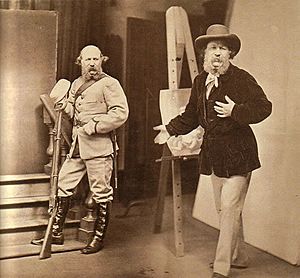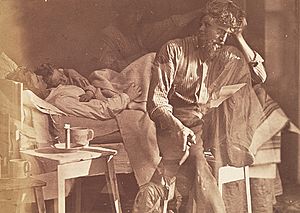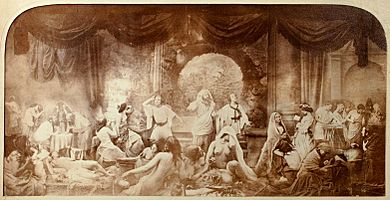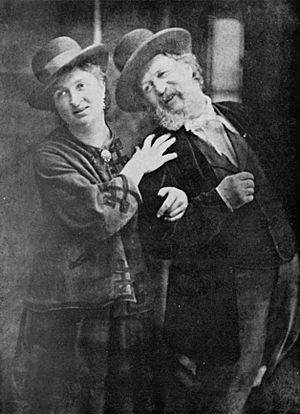Oscar Gustave Rejlander facts for kids
Oscar Gustave Rejlander (born in Stockholm, Sweden, on October 19, 1813 – died in Clapham, London, England, on January 18, 1875) was a very important early art photographer. He was a master at combining different photos to make one new picture, a technique called photomontage. He even worked with the famous scientist Charles Darwin on a book called The Expression of the Emotions in Man and Animals. This work helped him become known in the history of science and understanding human behavior.
Contents
Biography
Early Life and Moving to England
Oscar Rejlander was born in Stockholm, Sweden, in 1813. His father was a stonemason and an officer in the Swedish Army. When Oscar was young, his family moved to a Swedish-speaking town in Rauma, Grand Duchy of Finland (which was part of Russia back then).
In the 1830s, he moved to England. He first lived in Lincoln. In the 1850s, he stopped being a painter and miniaturist. He decided to become a photographer after seeing how well a photo could capture details, like the fold of a sleeve.
Becoming a Photographer
Around 1846, Rejlander opened a photography studio in Wolverhampton, an industrial town in the English Midlands. In the early 1850s, he quickly learned new photography methods like the wet-collodion process. He learned from Nicholas Henneman in London. After this, he changed his business to focus on photography. He took many different kinds of pictures, including portraits and scenes from everyday life.
Rejlander did many experiments to make his photography better. He was especially good at a technique called combination printing. This is where you combine several different photo negatives to create one single, new image. He didn't invent this method, but he made some of the most detailed and believable combined photos ever seen at that time.
In 1854, a newspaper called the Wolverhampton Chronicle wrote about his "Improvement in Calotypes." This showed he was already experimenting with combining negatives. He was also friends with another photographer, Charles Lutwidge Dodgson, who is better known as Lewis Carroll. Carroll collected Rejlander's photos and they wrote to each other about photography techniques. Rejlander later took one of the most famous portraits of Dodgson.
The Two Ways of Life
Rejlander showed his work at the Paris Exhibition in 1855. In 1856, he created his most famous artwork, called The Two Ways of Life. This was a huge montage made from thirty-two different images. It was like using Photoshop today, but it was much harder to do back then! It took him about six weeks to create.
The artwork was first shown in 1857 at the Manchester Art Treasures Exhibition. It shows a young man choosing between a path of good (virtue) and a path of bad (vice), guided by angels. At first, some people were unsure about the artwork. However, things changed when Queen Victoria bought a copy for ten guineas to give to Prince Albert. Queen Victoria and Prince Albert bought three copies of the artwork in total.
Despite this royal support, the artwork caused some debate in Scotland in 1858. Some people objected to how it was shown, with one half covered by drapes. This led to a group leaving the Photographic Society of Scotland. They later formed the Edinburgh Photographic Society in 1861. However, the Photographic Society of Scotland later made up for it. They invited Rejlander to a special dinner in his honor in 1866. This dinner was held to open an exhibition that included many of his pictures.
Later Work in London

Around 1862, Rejlander moved his studio to Malden Road in London. He mostly stopped his early experiments with double exposure, photomontage, and retouching. Instead, he became one of Britain's best portrait photographers. He created pictures that showed a lot of emotion.
He became a top expert in photography techniques. He gave many lectures and published articles about his work. He also sold his photos through bookshops and art dealers. In London, he found new subjects to photograph. He took pictures of homeless children, creating popular photos that showed social problems, like "Poor Joe" (also known as "Homeless").
Charles Lutwidge Dodgson (Lewis Carroll) visited Rejlander's London studio in 1863. Carroll was moving his own studio and asked Rejlander for advice on how to design it. Around 1863, Rejlander also visited the Isle of Wight. He went there because Julia Margaret Cameron asked him to, and he helped teach her about photography.
Some of Rejlander's images were bought by famous Victorian painters, like Sir Lawrence Alma-Tadema. These painters used the photos as aids for their own drawings. In 1871, Rejlander's photographs were included in Charles Darwin's famous book, The Expression of the Emotions in Man and Animals.
Personal Life
In 1862, Rejlander married Mary Bull. She was twenty-four years younger than him. Mary had been one of his photo models in Wolverhampton.
Rejlander became very sick around 1874. He died in 1875. After his death, the Edinburgh Photographic Society raised money for his wife. They also helped set up the Rejlander Memorial Fund to honor him. He is buried in Kensal Green Cemetery, and a new stone was placed on his grave in 2012.
Collections
Rejlander's work is kept in the permanent collections of many museums around the world. These include the San Francisco Museum of Modern Art, the Harvard Art Museums, the Clark Art Institute, the Victoria and Albert Museum, the J. Paul Getty Museum, the University of Michigan Museum of Art, the Princeton University Art Museum, the Museum of Fine Arts St. Petersburg, the Fine Arts Museums of San Francisco, the National Media Museum in Bradford, and the Museum of Fine Arts, Houston.
See also
- Victorian headless portrait, a type of photo that Rejlander helped create.





